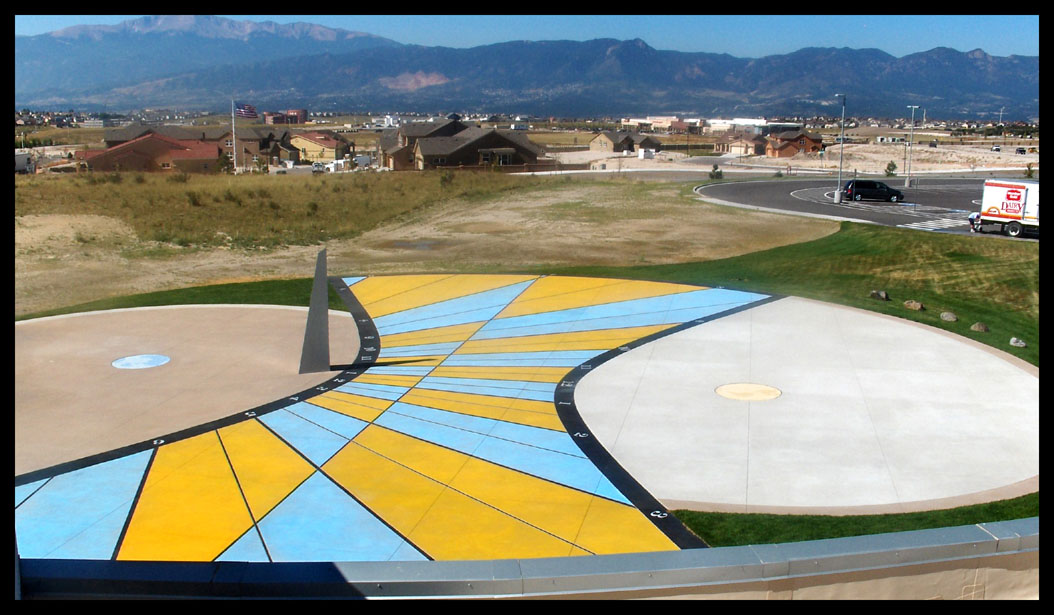The Chinook Trail Sundial
11795 Grand Lawn, Colorado Springs, 80924
Latitude: 38.96° N. Longitude: 104.73° W.
Installed August 2007
Webpage by John Carmichael (editor) and Dave Bell (webmaster)
This page was last updated 22 March, 2008


Sundial Graphics:
Overhead Photo: 1
Design Drawings: 1, 2, 3, 4
Gnomon Design Experiment Photos: 1, 2, 3
Construction Photos: 1, 2, 3, 4, 5, 6, 7, 8, 9, 10, 11, 12, 13
Equinox Photos: 1, 2
Winter Solstice Photos: 1, 2, 3, 4, 5, 6
Gnomon Photo: 1
Decorative Hemisphere Map Mosaics: 1, 2, 3
EOT & Information Plaques: 1, 2
Owner and Makers:
Commissioned by: Academy School District 20
Designers: John Carmichael and Chris Coulter
Dialist: John Carmichael
Head Contractor: Chris Coulter
Concrete Installers: Colorado Hardscapes, Denver CO, John Buteyn
Mosaic Artist: Juanita Canzoneri
Sundial Description:
Article in ‘The Compendium’, March 2008: Here
Type of Sundial: This is flat declining and inclining sundial that's nearly horizontal.
Face Shape: Face is shaped like a bow tie on round border.
Face Dimensions: diameter of round border: 120 feet.
Face Coloring: A "checkerboard" pattern of light yellow and light blue alternates between the hours and the equinox line. We used lithium quartz, acid stains, and acrylics - sometimes with water carriers and occasionally with acetone. The concrete was placed with a retarder that when removed, left the exposed sand finish. With this finish we were able to stain the concrete. The stain was applied with a roller in a single coat because two coats makes the surface look painted which I did not want. It will last six to eight years. The color will diminish in 6 to 8 years but will not vanish. Stain will need to be reapplied at that time to maintain brilliance.
Face Inclination: For water drainage, face slopes 2 feet in 120 feet = 1/60 = 1 degree.
Face Declination: Face declines to the south.
Time Lines: There are 4 inch wide black hour lines and 2 inch wide black half hour lines.
Time Notation: There are two numeral time notations: Mountain Standard Time numerals are on the north part of the face on a two foot wide black border, just outside of the Winter Solstice line, and Daylight Saving Time numerals are on the south part of the face just outside of the Summer Solstice line. Hour lines have built-in longitude shift to compensate for the distance and time shift from the Mountain Standard Prime Meridian. The longitude shift is quite small here being only .27° east of the Mountain Standard Time Meridian which is located at 105° W. longitude. For precision, the hour lines are corrected for this small longitude shift which equals only 1 minute and 5 seconds of time at this longitude.
Hour Numeral Font: Numerals are in Engravers MT Bold.
Date Lines: There are two curved 4 inch wide solstice lines and a straight equinox line.
Gnomon Description: Gnomon is a 12 foot tall inclining 3-sided pyramid with a truncated pointed top that slants at an angle that is equal to the polar axis. The northern corner of the gnomon is vertical and lies under the pointed tip. Gnomon is made of cast concrete.
Additional Artwork: There are two 6 foot round mosaic maps of the Eastern and Western Hemispheres that form part of the 120 ft round Yin Yang symbol.
Plaques: A bronze Equation of Time plaque and an instruction plaque are attached to the south side of the gnomon.
Photos: courtesy of Chris Coulter & John Carmichael
User Instructions:
To Obtain Solar Sundial Time
To tell Solar Time corrected for longitude shift, estimate the time by noting the position of the tip of the gnomon's shadow in reference to the hour lines next to it on the face. Note that Solar Time is not always the same as Watch Time and will sometimes be slightly ahead of or behind Watch Time. To convert Solar Sundial Time to Watch Time, read the section below.
To Obtain Watch Time
First, determine Solar Sundial Time, then, using The Equation of Time graph, add or subtract the number of minutes shown on the graph for today's date, to or from the time shown on the sundial. The hour numerals on the North, the East and the West sides of the dial tell Mountain Standard Time, and the hour numerals on the South side tell Daylight Saving Time.
To Tell the Time of Solar Noon
At Solar Noon, the sun is due south and is at its highest altitude above the horizon for the day. At this moment, the shadow of the gnomon's tip points due North. Due to the small longitude shift, Solar Noon (due North), is at 11:58:55 am Solar Sundial Time when Standard Time is in effect, and at 12:58:55 pm Solar Sundial Time when Daylight Saving Time is in effect. When the shadow is at this point, if you apply the Equation of Time, you can determine Watch Time of Solar Noon.
To Tell the Date
The North curved border is the Winter Solstice line, the South curved border is the Summer Solstice line, and the straight East/West line in the center is the Equinox line. Estimate the date by noting the position of the gnomon's tip in reference to these lines.
To Tell the Cardinal Points of the Compass
The straight Equinox line lies directly East and West. The gnomon's shadow at Solar Noon points due North.
Contact:
John L. Carmichael
Sundial Sculptures
925 E. Foothills Dr.
Tucson AZ 85718-4716
USA
Tel: 520-6961709
Email: John Carmichael (author)
Email : Dave Bell (webmaster)
My Websites:
(business) Sundial Sculptures: http://www.sundialsculptures.com
(educational) Chinook Trail Sundial: http://advanceassociates.com/Sundials/COSprings/
(educational) Earth & Sky Equatorial Sundial: http://advanceassociates.com/Sundials/Earth-Sky_Dial/
(educational) My Painted Wall Sundial: http://www.advanceassociates.com/WallDial
(educational) Painted Wall Sundials: http://advanceassociates.com/WallDial/PWS_Home.html
(educational) Stained Glass Sundials: http://www.stainedglasssundials.com
(educational) Sundial Cupolas, Towers & Chimneys: http://StainedGlassSundials.com/CupolaSundial/index.html

